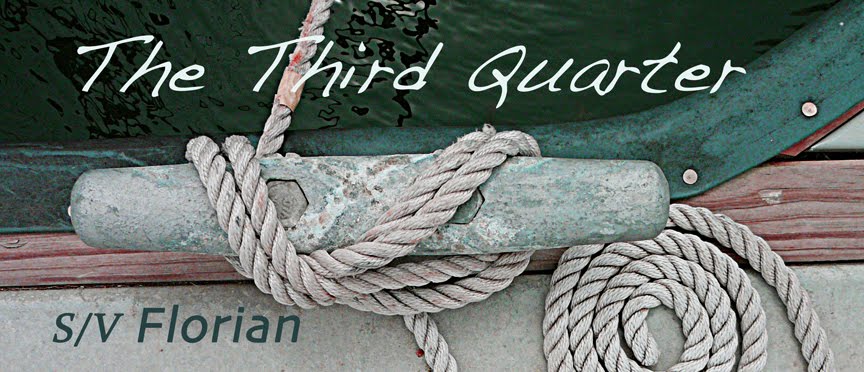 |
| Aerial view of Ventura Isle Marina (photo courtesy of Almar Marinas) |
Last summer, when Don and I were just starting to assemble our plan to buy a sailboat, we visited several California marinas - to meet with brokers and look at boats on the market, as well as slips.
I remember multi-year wait-lists for slips back in the 80's in Santa Barbara, so I was surprised at the empty/available slips in every marina we visited - evidence of sad economic fluctuations. (I wonder where all of those boats went? Where are they now, if they aren't in marina slips?)
Through out the summer and into last Fall, we gathered brochures, looked at amenities, met with marina administrators and walked the docks - sometimes for hours, because we were enjoying the coastal atmosphere, comparing all the makes, models and sizes of boats, and soaking up the environment.
 |
| Walking along Ventura Isle Marina near A & B Dock |
After we purchased Florian, and had a confirmed LOA (Length Overall - needed to calculate the size & cost of the slip. Don grumbles that LOA always includes the bowsprit, so you have to pay more for a plank of wood extended beyond the bow.) We returned to the marinas we were considering, and took a closer look at what was available for a 36ft boat. After repeated visits to our top choices, we knew we wanted to keep Florian at Ventura Isle Marina. We marked dock maps with our preferences, and waited for Spring, and Florian's arrival from Maine.
 |
| Kayak & Paddle Boat rentals, shops and restaurants at Ventura Harbor Village (photo courtesy of Vicki Leigh) |
 |
| Coast of Southern California with Channel Islands (photo courtesy of NASA) |
♥ We live about an hour from the coast, and the drive to the marina meanders through citrus groves and farms. That's not a bad weekend commute when you live & drive on the freeways of Los Angeles.
♥ Ventura Isle is owned and managed by a marina company that has reciprocal privileges at all their marinas. So, lets say we want to sail to San Diego, or San Francisco. We simply call our marina office, and they make arrangements for a guest slip for us, no charge.
♥ The Channel Islands National Park is - at it's closest point - 14 miles from the Marina. This chain of five islands are laced with hiking trails, protected anchorages, sea caves, diving, kayaking, camping and an amazing assortment of wildlife. The islands also host the largest aggregation of bue whales in the world. The accumulated pristine coastline spans 175 miles. We plan to spend a lot of time exploring this beautiful treasure of islands.
♥ We spend most weekends on the boat, and if we don't feel like cooking, we can walk the curve of the harbor to Ventura Harbor Village for dinner at any number of great restaurants. There's also a variety of bands performing every weekend in the village, so we can sit in our cockpit to watch the sea lions, cormorants and the sunset with a live musical score.
♥ We have great neighbors. (This one is very important, because you're all hanging out in very close proximity.) The day we walked the dock to look at available slips marked on the map, a gentleman with a big smile, an effusive Italian accent, and a cute little dachshund named Roma popped out of his Catalina 33 companionway to say hello. He asked if we were considering the empty slip next to him. When we confirmed that we were, he gave us some insights about other folks on the dock, and shared the reasons he thought it was the best place in the marina. He was right. We love it there, and we count down the week days to each Friday so we can get back to our waterfront property on board Florian.
What was on your list for the Right Marina?
 |
| Aerial view of Ventura Isle Marina, surrounded by ocean & farmland. (photo courtesy of Almar Marinas) |
 |
| Ventura Harbor Village Fishing Boats, Dive Charters & Water Taxis |
 |
| s/v Florian in her slip at the marina |






















